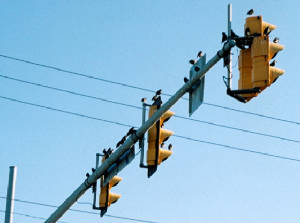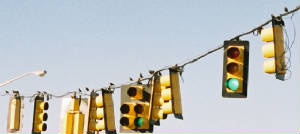|

|
|
TWENTY birds on a wire over a busy intersection?
Isn’t that surprising? Counterintuitive?
Why are they there?
Why aren’t they in trees?
|
|

|
|
Seriously? Do you know?
Can you formulate a theory?
|
|

|
When I left the subway culture of Manhattan and moved back to Virginia where I had
to drive every day, one of the first things I noticed was all the birds sitting on wires or traffic lights over intersections.
|
That’s odd, I thought. There’s nothing up there. No food, no water,
no protection from the sun and wind. What a cheerless, metallic, plastic, unfriendly, unnatural place for a bird to be. There’s
nothing growing. There’s hardly a decent perch. Not to mention the noise. The polluted air. The huge machines racing
by 7’ below. The constant danger of being smashed to death. There’s absolutely nothing to do up there. Nothing
to do but...watch us...
|
Hmmm. What an interesting idea, I thought. Could it actually be true?
I started asking people, “You ever see birds on the wires over intersections? Why do you think they’re there?”
Funny thing. Every person I talked to had some completely goofy idea: They want the heat in the pipes. They want
to be close to the electricity. They’re eating the tape or plastic or whatever. There’s food and water up there--you
just can’t see it. Their ancestors--many generations ago--roosted in trees at the same locations; and the birds today
are "imprinted" with those locations...The only thing everybody agreed on was that my theory was silly. No, not
possible!
I even called a biology professor at a local college and he said, dismissively, “I don’t
think they’re there because of us.” |
Well, as some of you may have noticed, I love being a contrarian. If everybody disagrees
with me, I’m more sure that I’m right. The nay-sayers convinced me that the birds were there for one reason only.
To watch us. Maybe not us personally. But our shiny metal cars, our activities, our colors, our speed.
Although
sometimes we--personally--had to be the attraction. Many birds flock to big signs by busy stores. Here the cars are fewer;
the people many. Oh yes, I decided, they’re watching us, all right. Maybe hanging out together is a little strong. But
they are where they are because we are there. People aren't the only ones who enjoy people-watching.
Note, in
every case, there are always trees not far off. There are wires a block or two from the highway. But the birds, many of them,
seem to prefer to be literally on top of the action! (Or close. Some birds will find a spot about 20 feet to the side of a
major highway. Close enough to watch the parade but not be on top of it.) But why?
|
One of the biggest intersections anywhere: ten lanes north-south, ten lanes east-west. (Virginia
Beach Boulevard, Independence Boulevard. The wires in front of Taco Bell are
a very popular spot.)
|
|
As the song says:
“How you gonna keep them down on the farm after they’ve seen Paree?”
|
|
Think for moment about the brain. What is it? A stimulus processor, that’s all. If there’s no stimuli, the brain
is restless, unhappy, not sure what the point of existence is. The first concerns may be safety and food. These city birds
have never seen a human shoot a bird, so they’re relaxed about danger. How much time can a bird spend eating? Once
these basic necessities are taken care of, the brain starts looking around for something interesting.
|
|
When I lived in Manhattan, the geniuses who ran the New York State hospital system exiled 100,000 mental patients onto the
streets. Many of them found their way to busy places such as Times Square. Some friends found this odd. I never did. I thought,
If I were labeled less than sane, if I were a person with no duties and expectations, I’d probably enjoy sitting around
on the curb at Times Square myself. Lots to look at. Lots of stimulation, you might say. Something happening every second.
I believe our bird friends are reacting in exactly that way. (In fact, maybe a mentally ill person is a bit more like a bird
than the rest of us. Or vice versa.)
|
|
In any event, I notice these birds almost every day. Ten or twenty on one wire is common. Fifty in one busy intersection
is common. They are rarely in the same spot an hour later or a day later. They move around in odd unpredictable ways. But
they are there a lot. And I have to conclude they like watching us.
I say they are like us. I say they like us.
Well, I’m just a provocateur. Some properly qualified person should check this out. Smarter theories are welcome. If
you have photos better than these, let me know; I’ll put them up.
The law firm down the hall advises me to say: DO NOT BIRD-WATCH AND DRIVE AT THE SAME TIME. THE BIRDS WILL LAUGH WHEN YOU
RUN INTO ANOTHER CAR. MAYBE THAT'S IT. AN INTERSECTION IS NASCAR FOR BIRDS!?
|
|
Norfolk, Virginia Beach, Virginian Pilot, Beacon, Hampton Roads
|
© Bruce Deitrick Price 2011
|
|